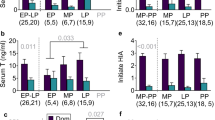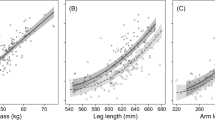Abstract
Although dominant African wild dogs (Lycaon pictus) are generally believed to be the sole breeders within a pack, earlier behavioral and endocrine data suggest that reproduction could be shared with subordinates. We performed an extensive behavioral, demographic, and genetic evaluation of a wild dog population in South Africa to examine the level of such sharing and the proximate mechanisms influencing reproductive contributions of each sex. While a majority of pups were born to dominants because of a lack of subordinate potential breeders, we discovered a substantial portion of reproductive sharing between dominants and subordinates. Compared with alpha females that mated annually, subordinate beta females bred in 54.5% of years whereas thetas never bred. The three top-ranking males all sired pups (56.0%, 32.0%, and 12.0%, respectively) when three or more adult males were present. With only two pack males, alpha and beta individuals shared reproduction nearly equally (55.2% and 44.8%, respectively), and litters of mixed paternity were discovered on eight of 15 (53.3%) occasions. A skewed adult sex-ratio and frequent alpha mortalities for females and behavioral aggression in males allowed most individuals to attain dominant status in their lifetime, creating a constantly shifting social hierarchy. Genetic parentage results corresponded to reported hormone profiles, suggesting physiological suppression in some lower-ranked individuals of both sexes. Thus, a combination of demographic, behavioral, and hormonal proximate factors mediates reproductive partitioning in wild dogs. We conclude that reproductive sharing can be significant in this species, especially for males that have less robust suppressive mechanisms than females.

Similar content being viewed by others
References
Alberts SC, Watts HE, Altmann J (2003) Queuing and queue-jumping: long-term patterns of reproductive skew in male savannah baboons, Papio cynocephalus. Anim Behav 65:821–840
Barrett J, Abbott DH, George LM (1993) Sensory cues and the suppression of reproduction in subordinate female marmoset monkeys, Callithrix jacchus. J Reprod Fertil 97:301–310
Birkhead TR, Moller AP (1992) Sperm competition in birds: evolutionary causes and consequences. Academic, London
Clarke FM, Faulkes CG (1997) Dominance and queen succession in captive colonies of the eusocial naked mole-rat, Heterocephalus glaber. Proc R Soc Lond B 264:993–1000
Creel S, Creel NM (2002) The African wild dog: behavior, ecology, and conservation. Princeton University Press, Princeton
Creel S, Waser P (1991) Failures of reproductive suppression in dwarf mongooses (Helogale parvula): accident or adaptation? Behav Ecol 2:7–15
Creel S, Creel NM, Mills MGL, Monfort SL (1997) Rank and reproduction in cooperatively breeding African wild dogs: behavioral and endocrine correlates. Behav Ecol 8:298–306
Creel S, Mills MGL, McNutt JW (2004) Demography and population dynamics of African wild dogs in three critical populations. In: Macdonald DW, Sillero-Zubiri C (eds) Biology and conservation of wild canids. Oxford University Press, Oxford
Estes RD, Goddard J (1967) Prey selection and hunting behaviour of the African wild dog. J Wildl Manage 31:52–69
Faulkes CG, Abbott DH (1991) Social control of reproduction in breeding and non-breeding naked mole-rats (Heterocephalus glaber). J Reprod Fertil 93:427–435
Faulkes CG, Bennett NC (2001) Family values: group dynamics and social control of reproduction in African mole-rats. Trends Ecol Evol 16:184–190
Frame L, Malcolm J, Frame G, Lawick HV (1979) Social organization of African wild dogs (Lycaon pictus) on the Serengeti plains, Tanzania, 1967–1978. Z Tierpsychol 50:225–249
French JA (1997) Proximate regulation of singular breeding in Callitrichid primates. In: Solomon NG, French JA (eds) Cooperative breeding in mammals. Cambridge University Press, Cambridge
Fuller TK, Kat PW, Bulger JB, Maddock AH, Ginsberg JR, Burrows R, McNutt JW, Mills MGL (1992) Population dynamics of African wild dogs. In: Barret DR, McCullogh RH (eds) Wildlife 2001: populations. Elsevier Science, London
Girman DJ, Mills MGL, Geffen E, Wayne RK (1997) A molecular genetic analysis of social structure, dispersal, and interpack relationships of the African wild dog (Lycaon pictus). Behav Ecol Sociobiol 40:187–198
Gottelli D, Wang J, Bashir S, Durant SM (2007) Genetic analysis reveals promiscuity among female cheetahs. Proc R Soc Lond B 274:1993–2001
Huck M, Lottker P, Heymann EW (2004) Proximate mechanisms of reproductive monopolization in male moustached tamarins (Saguinus mystax). Am J Primatol 64:39–56
Kappeler PM, Port M (2008) Mutual tolerance or reproductive competition? Patterns of reproductive skew among male redfronted lemurs (Eulemur rufus). Behav Ecol Sociobiol 62:1477–1488
Madsen T, Shine R, Loman J, Hakansson T (1992) Why do female adders copulate so frequently? Nature 355:440–441
Malcolm JR, Marten K (1982) Natural selection and the communal rearing of pups in African wild dogs (Lycaon pictus). Behav Ecol Sociobiol 10:1–13
Marshall TC, Slate J, Kruuk LEB, Pemberton JM (1998) Statistical confidence for likelihood-based paternity inference in natural populations. Mol Ecol 7:639–655
McNutt JW, Silk JB (2008) Pup production, sex ratios, and survivorship in African wild dogs, Lycaon pictus. Behav Ecol Sociobiol 62:1061–1067
Miller CR, Joyce P, Waits LP (2002) Assessing allelic dropout and genotype reliability using maximum likelihood. Genetics 160:357–366
Moehlman PD (1979) Jackal helpers and pup survival. Nature 277:382–383
Moueix C (2006) Genetic verification of multiple paternity in two free-ranging isolated populations of African wild dogs (Lycaon pictus). MSc thesis, University of Pretoria, Pretoria
Nakamura M (1998) Multiple mating and cooperative breeding in polygynandrous alpine accentors. Anim Behav 55:259–275
Ortega J, Guerrero JA, Maldonado JE (2008) Aggression and tolerance by dominant males of Artibeus jamaicensis: strategies to maximize fitness in harem groups. J Mammal 89:1372–1378
Packard JM, Seal US, Mech DL, Plotka ED (1985) Causes of reproductive failure in two family groups of wolves (Canis lupus). Z Tierpsychol 69:24–40
Reich A (1981) The behavior and ecology of the African wild dog (Lycaon pictus) in the Kruger National Park. PhD thesis, Yale University, New Haven
Reyer H, Dittami JP, Hall MR (1986) Avian helpers at the nest: are they psychologically castrated? Ethology 71:216–228
Richardson DS, Jury FL, Blaakmeer K, Komdeur J, Burke T (2001) Parentage assignment and extra-group paternity in a cooperative breeder: the Seychelles warbler (Acrocephalus sechellensis). Mol Ecol 10:2263–2273
Rood JP (1990) Mating relationships and breeding suppression in the dwarf mongoose. Anim Behav 28:143–150
Russell JK (1983) Altruism in coati bands: nepotism or reciprocity? In: Wasser SK (ed) Social behavior of female vertebrates. Academic Press, New York, pp 263–290
Savage A, Ziegler TE, Snowdon CT (1988) Sociosexual development, parent bond formation and mechanisms of fertility suppression in the female cotton-top tamarins (Sanguinus oedipus oedipus). Am J Primatol 14:345–359
Schenkel R (1967) Submission: its features and function of the wolf and dog. Amer Zool 7:319–329
Sherman PW, Seeley TD, Reeve HK (1998) Parasites, pathogens, and polyandry in honey bees. Am Nat 151:392–396
Somers MJ, Graf JA, Szykman M, Slotow R, Gusset M (2008) Dynamics of a small re-introduced population of wild dogs over 25 years: Allee effects and the implications of sociality for endangered species recovery. Oecologia 158:239–247
Spiering PA, Gunther MS, Wildt DE, Somers MJ, Maldonado JE (2009) Sampling error in non-invasive genetic analyses of an endangered social carnivore. Conserv Genet. doi:10.1007/s10592-009-9880-6
Taberlet P, Griffin S, Goossens B, Questiau S, Manceau V, Escaravage N, Waits LP, Bouvet J (1996) Reliable genotyping of samples with very low DNA quantities using PCR. Nucleic Acids Res 2:3189–3194
van Lawick H (1970) Wild dogs. In: van Lawick H, van Lawick-Goodall J (eds) The innocent killers. Houghton Mifflin Co., Boston, pp 47–101
Waits LP, Luikart G, Taberlet P (2001) Estimating the probability of identity among genotypes in natural populations: cautions and guidelines. Mol Ecol 10:249–256
Wingfield JC, Silverin B (1986) Effects of corticosterone on territorial behavior of free-living Song Sparrows, Mdospha mtiodia. Horm Behav 20:405–417
Wolff JO, Macdonald DW (2004) Promiscuous females protect their offspring. Trends Ecol Evol 19:127–134
Woodroffe R, Davies-Mostert H, Ginsberg J, Graf J, Leigh K, McCreery K, Robbins R, Mills G, Pole A, Rasmussen G, Somers M, Szykman M (2007) Rates and causes of mortality in endangered African wild dogs Lycaon pictus: lessons for management and monitoring. Oryx 41:215–223
Acknowledgments
We thank Ezemvelo KwaZulu-Natal Wildlife, especially the management teams at Hluhluwe-Imfolozi Park and the uMkhuze section of iSimangaliso Wetland Park. We also appreciate the assistance of Thanda Private Game Reserve and their wildlife management team. We are grateful to Rob Fleischer, Emily Latch, Sarah Haas, Kalon Armstrong, and Nancy Rotzel of the Smithsonian's Center for Conservation and Evolutionary Genetics for laboratory support and assistance with protocols and procedures. Sarah Arnoff, Jan Graf, Gabriella Flacke, Mariana Venter, Carla Naude-Graaff, Sboniso (Zama) Zwane, and Chris Kelly provided invaluable assistance in monitoring and sample collection in the field. This research was supported by funding from the Smithsonian Institution Undersecretary for Science Endowment, University of Pretoria, Rotterdam Zoo Thandiza Fund, Humboldt State University, Conservation Endowment Fund of the Association of Zoos and Aquariums, Disney Wildlife Conservation Fund, Knowsley Safari Park, DST-NRF Centre of Excellence for Invasion Biology, Khaki Fever Work Wear, Pittsburgh Zoo Conservation Fund, and the Morris Animal Foundation. International travel was generously provided by British Airways.
Author information
Authors and Affiliations
Corresponding author
Additional information
Communicated by A. Schulte-Hostedde
Rights and permissions
About this article
Cite this article
Spiering, P.A., Somers, M.J., Maldonado, J.E. et al. Reproductive sharing and proximate factors mediating cooperative breeding in the African wild dog (Lycaon pictus). Behav Ecol Sociobiol 64, 583–592 (2010). https://doi.org/10.1007/s00265-009-0875-6
Received:
Revised:
Accepted:
Published:
Issue Date:
DOI: https://doi.org/10.1007/s00265-009-0875-6




